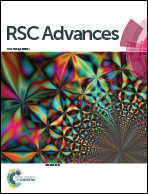Nanotemplate-directed DNA segmental thermal motion†
Abstract
DNA adsorption on molecular nanotemplates represents a promising system for use both in fundamental studies and biotechnological applications. Using atomic force microscopy (AFM) operated in a liquid, we have investigated the conformation and real time thermal motion of phage T7 DNA adsorbed on stearylamine and stearic acid nanotemplates on highly oriented pyrolytic graphite (HOPG) in aqueous solutions. Though local linear straightening of adsorbed DNA segments along the lamellas of nanotemplates was always observed, DNA adsorbed on a stearic acid nanotemplate revealed a larger surface coverage and higher mobility, indicating a weaker DNA–surface interaction than for a stearylamine nanotemplate. The DNA adopted a nearly two-dimensional conformation on the molecular nanotemplates, which can be described by a two-dimensional compact globule state for stearylamine and by a model of a self-avoiding walk for stearic acid. Unlike previously reported thermal motion of single DNA molecules, DNA segmental thermal motion on the nanotemplates mostly proceeded along preferred directions, defined by the lamellas of the nanotemplates. However, DNA hopping to adjacent lamellas and out-of-plane movement (movement through temporary desorption of DNA segments) were also observed. Owing to their peculiar properties, molecular nanotemplates on graphite are ideal candidates for utilization as model substrates for AFM studies of two-dimensional conformations of DNA at the nanoscale, for exploring conformational relaxation times of DNA on a single molecule level and for investigation of the dynamics of DNA–protein interaction.


 Please wait while we load your content...
Please wait while we load your content...